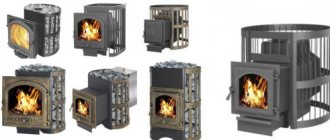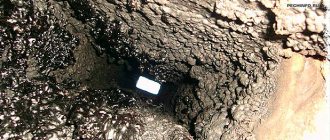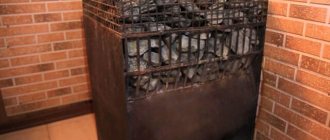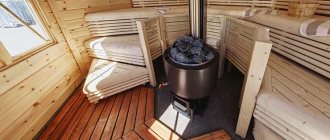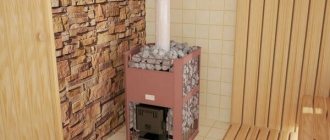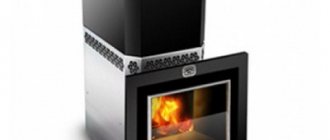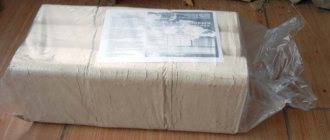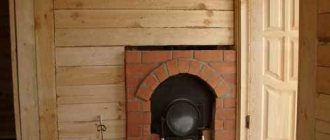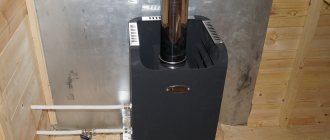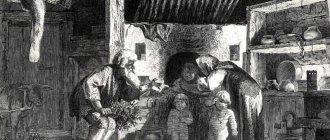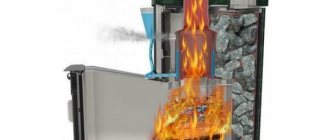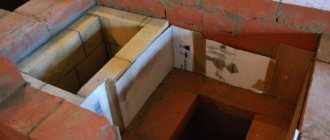In a new bathhouse - with new steam and a new stove! But which model to choose so that the steam is thick, the air temperature is as needed, and at the same time you don’t have to perform “dances with a tambourine” - i.e. constantly add wood to the stove and adjust something? Then it’s time to opt for the Vulcan sauna stove - powerful and really hot! So, the Vulcan sauna stove is designed for a steam room from 8 to 30 cubic meters. And it is produced in two versions - with a firebox half a centimeter thick and with a firebox with parameters of 0.25 cm. Different materials are also used for the manufacture of the firebox: carbon steel for thick walls and steel with heat-resistant characteristics for the second option. In total, there are as many as seven types of the Vulcan stove, and a dozen modifications. We will talk about all its pros and cons in this article.
Design Features
Vulcan sauna stoves are produced with a thick firebox wall – 5mm carbon steel, which are additionally reinforced in areas of greatest load (here the thickness can reach 10mm). To make it convenient to clean the firebox and ventilation ducts from soot, there is a special hole with a lid on the top panel of the stove. The cast iron grates in Vulcans have a specific shape. They are designed so that even damp wood burns efficiently (it is often undesirable to burn with damp wood - the stove and chimney will quickly become overgrown with soot).
Bath stove "Vulcan". Design Features
After studies of “spent” own furnaces, carried out jointly with MSTU “Stankin”, certain design changes were made to the design of the “Vulcan” furnaces. A complex labyrinth of dividers appeared in the firebox, with the help of which the heated air is retained inside for as long as possible. In this way, maximum heat transfer from the heated air is achieved to the walls of the furnace and stones, and through them to the air in the steam room. To increase reliability, additional stiffening ribs were welded into the firebox. These fins simultaneously increase the heat transfer area, increasing the efficiency of the stove and the heating rate of the steam room and stones.
During the improvement, much attention was paid to welded seams, since they are the weakest link in any firebox. To prevent the seams from coming into contact with water, they are all made from the outside. To avoid deformation during heating, the new design is designed in such a way that almost the entire mass of the chimney falls on the reinforced pipe.
Oven "Vulcan Etna 20" with panoramic door and cast iron
Glass doors in wood-burning stoves are beautiful, but many have encountered the fact that the glass cracks due to temperature changes. The new Vulcan ovens are equipped with German doors with Schott Robax glass, which can be operated at temperatures up to 760°C. Moreover, what is more important, they do not crack under large differences: the temperature at the edges can be +50°C, and in the middle +500°C, and the manufacturer guarantees the absence of cracks. Their declared service life is 20 years.
Stove "Vulcan" for a bath. Schematic representation of the main design solutions
The design is well thought out from a safety point of view. A double metal screen is made to protect against hard radiation. It also serves as good protection against burns, since the temperature of the outer casing is not so high. The air flow created between the two layers of walls contributes to a more complete transfer of thermal energy into the air. Manufacturers also claim protection against the entry of combustion products (in particular, carbon monoxide) into the steam room by creating powerful draft.
All the improvements and changes in the design have led to the fact that instead of the previously stated 10 years of operation, today the service life of Vulcan bathhouse stoves has been doubled: manufacturers say that under normal operation they will last 20 years.
Standard equipment overview
Powerful and functional Vulcan sauna stoves have a fairly traditional design for metal stoves . The traditional Vulcan stove consists of a firebox, an outer casing made of steel 2-3 mm thick, a compartment for laying stones and, if desired, a stainless steel water tank.
“Vulcan” is sold today with and without a built-in tank. In the first option, a closed tank with outlet and inlet pipes is welded inside the furnace - these can be connected to another separate tank.
The outer casing of the Vulcan stove serves to protect against excessive thermal radiation and to form convection air flows that remove heat from the firebox, and the middle contour is a niche for stones and protects the outer walls of the stove from unnecessary heating. But inside the firebox there is a rather complex labyrinth that allows you to effectively use the thermal energy from the fire. In addition, on the top there are ribs that increase the total area of heat transfer surfaces. This way the stones heat up more intensely and evenly, and the firebox itself lasts much longer.
As additional equipment for the Vulcan series heater stoves, there are also pipes, tanks on pipes, stones and special structures, the purpose of which is to isolate the pipes themselves from wooden floors. But such protection must be provided - some bathhouse attendants, who have a metal pipe connected to the Vulcan, complain that the casing of the steam room has darkened.
A good flow of hot air from the Vulcan is ensured due to the fact that the vertical openings intended for laying stones are narrow - this was intended.
Review of some models of Vulcan sauna stoves and reviews of them
Let's look at the pros and cons of Vulcan sauna stoves using specific models as examples. The “Vulcan” stove of the Elbrus 26 model in the “standard” modification can heat a steam room with a volume of 12 to 26 cubic meters. m. It has a powerful turbo firebox with a wall thickness (in areas of greatest load) of 10 mm. Main parameters of the furnace:
- width – 500 mm;
- depth - 720 mm;
- height - 800 mm;
- weight – 100 kg;
- weight of loaded stones up to 125 kg (in the model with a built-in stone tank 100 kg, with a heat exchanger 110 kg).
Taking into account consumer reviews, we can say that Elbrus-26 is a very efficient and reliable sauna stove with high heat output and a long service life. Due to its light weight, it is easy to install (two people required) and very easy to use. It can be equipped with a built-in 35-liter water tank; it is possible to install a heat exchanger (it can be installed to the right or left of the firebox). The pipe can be of two diameters: for a pipe 115mm and 110mm. As a disadvantage, the water in the built-in tank heats up too quickly: you have to drain hot water and add cold water, but this problem does not exist when using a remote tank.
Oven "Vulcan Elbrus" with a standard door and glass
The Vulcan Etna 20 stove (premium modification) looks very aesthetically pleasing. The panoramic door adds chic (photo above). The non-standard design - the stove is made in the shape of a large vase - deserves attention. The Etna 20 model has ribs on the body and on the pipe mesh, which provide high heat transfer: the stones laid between them heat up faster and to higher temperatures. Among the shortcomings of the model, only one circumstance can be highlighted: some users consider the stove to be too hot (this is for a Russian steam room; for use as a dry-air Finnish sauna, this stove is very good). To eliminate this drawback, you can cut off some of the fins, thereby reducing the heat transfer area.
With two heaters - open and closed - another model "Volcano Prometheus" is produced; stone laying here is 100 kg in the modification "Prometheus 16" and 200 kg in the "Prometheus 24". This is also a good and more budget option for a sauna, but you need to take into account that there is no water tank.
Stove "Volcano Prometheus" with an external heater (with and without mesh for the pipe)
More compact are the Vulcan Elbrus 16 stoves (optionally equipped with a “panorama” door or a regular size with glass). Its dimensions: 540*400*800mm, weight – 80kg, weight of laid stones – 75kg. Used for steam rooms from 6m3 to 16m3. Like other members of the family, it has a cast iron grate, which ensures high-quality combustion even of damp wood. The disadvantages of this model (and not only this one) include high heat transfer. Some users note darkening of wooden cladding due to excess heat, therefore it is advisable to erect protective screens or cladding adjacent structures with heat-resistant materials. A significant disadvantage is the lack of a built-in water tank and the inability to install a heat exchanger. This is due to the small size of the oven. As a way out, you can use mounted tank options (read about the types of water tanks here). Overall, a good budget option for small steam rooms.
New - cast iron sauna stoves ETNA
The ETNA stove, which is more efficient in its functionality, has appeared on the modern market for the production of sauna stoves. The stove is simple and reliable, made of three cast iron elements. Due to the laid specialized cord and reliable fastening with bolts, complete safety during its operation is achieved.
A cast iron sauna stove is ideal for fast heating and efficient heat transfer, which directly affects the heating of the room and maintaining heat. True connoisseurs of healthy steam prefer wood-burning stoves only, which ensures an ideal healthy climate in the bathhouse.
The manufacturer of this product was able to create a reliable and high-quality product that is significantly superior to other stoves in its functionality and performance characteristics. An important aspect is also the safety of using the stove, on which special emphasis was placed. As a result of numerous tests, impressive results were achieved and this stove was created.
Cast iron sauna stove ETNA with a blind door
Cast iron sauna stove ETNA with glass
The undeniable advantages of the cast iron stove for the Etna bath
- cast iron is a heat-intensive and very durable material, which has a positive effect on its service life;
- fast heating and good heat dissipation;
- There is no burning of oxygen in the steam room; as a result of using the stove, healthy steam is obtained that is beneficial for the body;
- Various modifications of stoves allow you to select a stove for a specific room with its maximum efficiency;
- a large selection of stove models, from stoves with solid cast iron doors, to models with glass, from small ones, to panoramic doors up to 60 cm diagonally;
- possibility of installing a stove for heating from an adjacent room with a steam room.
The variety of cast iron stoves for Etna baths allows you to choose the most suitable option for any room, regardless of its size. A healthy atmosphere in the bathhouse directly depends on what kind of stove will be used. An important point for a healthy climate in the bathhouse is to use wood-burning sauna stoves, which create a microclimate more favorable for the human body.
Price aspect
The price aspect of this product is significantly small compared to all the ensuing advantages. Buying a cast iron sauna stove can now be much cheaper. Due to large sales volumes, prices have become an order of magnitude lower, and the range has increased significantly. Sauna stoves made of Etna cast iron are very popular among numerous customers, as evidenced by numerous positive reviews.
Heating stoves "Vulcan Alpina"
In addition to bathhouses, Vulcan also produces Alpina heating stoves in several modifications. These powerful stoves are designed to heat large rooms. Even the smallest of them (the “mini” modification) can heat a room with a volume of up to 50 m3. But “Mini” is positioned as a heating wood stove for non-residential premises: its appearance is not the most presentable, but the power for its small size (500 * 310 * 570 mm) is very decent. The stove can only be heated with wood; the size of the log is no more than 45 cm.
Heating stoves “Vulcan Alpina” (Mini on the right)
The second most powerful model of this family, Alpina-200, can heat a room of up to 200 m3. The most powerful “Alpina 250” is designed for a volume of 250 m3. The firebox is made of carbon steel 5mm thick. There is a channel for afterburning gases, which ensures long-term combustion: one full load of firewood burns for 15-20 hours. This model has two fuel doors, which allows you to stack the maximum amount of firewood and achieve long burning. For maximum heat transfer, the housing has corrugated walls. If you want to organize air heating of the room - Alpina is an effective and inexpensive solution, and the stove is compact - 614 * 412 * 725 mm, weight 85 kg. Easy to install: a non-flammable base is required, which can be a sheet of iron laid on an asbestos sheet or any other heat-insulating material. It is also necessary to connect a chimney with efficient draft. There are no other requirements.
Volcano stove: consumer reviews
Installation and principle of operation of the Vulcan stove.
Today, stoves are one of the most popular in their market segment. The company manages to maintain its high position thanks to the quality of its products. Thus, Vulcan stoves of different models have undeniable advantages, for example:
- Price. Taking into account the high quality of the stoves, their cost is quite adequate, which is important for domestic consumers.
- Economical. We have all learned to count money very well, so we understand perfectly well: the costs of the structure itself are just the tip of the iceberg. It is also important how economical and easy to use it is. Vulcan stoves are an excellent choice for people who do not want to overpay for fuel and maintenance of the structure.
- Easy to maintain. To maintain the functionality of the stove, you do not need to invite specialists or study literature. Anyone can take care of its technical condition. The manufacturer has provided all the nuances, so understanding the device is easy.
- Reliability. The volcano stove for the bath is “indestructible”. It can be used for several decades without thinking about major repairs or replacement. The main thing is to regularly clean and monitor its condition.
- Functionality. Such stoves can be installed in fairly large rooms. Another plus is the ability to control the temperature. One stack of firewood is enough to maintain the desired temperature in the bathhouse for up to 4 hours.
- Unpretentiousness. Volcanoes are “omnivorous”; they can be drowned with any solid fuel.
- Compactness. The small size and light weight of the stoves delight buyers who cannot afford large areas in the bathhouse for a stove. Additional advantages are less effort and money spent on transportation and installation of the structure.
- Thoughtfulness. The manufacturer has taken care to get the maximum benefit even from smoke. It does not immediately go into the chimney, but passes through a labyrinth of special channels, which increases efficiency and allows large areas to be heated using a relatively small stove.
As for the shortcomings, most consumers agree that there are simply no significant flaws that poison the life of the owner of a bathhouse with a Vulcan stove.
